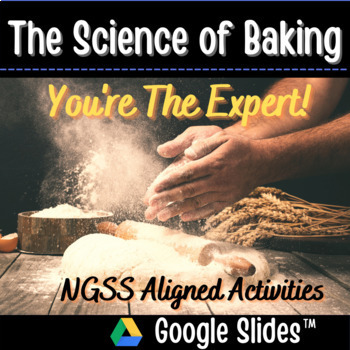Science of Baking: You're the Expert! Authentic Assessment
- Google Drive™ folder

Description
Have you just finished teaching pure substances, mixtures, physical & chemical changes, conservation of mass, and synthetic vs. natural materials? If you are looking for an authentic assessment for your students to demonstrate knowledge and skills then this is the resource for you and it works well whether you are in person, virtual or hybrid. This project engages the interest of students because it involves something they all love....FOOD!
The Science of Baking: Cinnamon Rolls
This immersive experience puts students in the seat of a content creator developing content for an episode of a show on baking that explores the changes that occur and how we know a new product has been made. Along the way they will have to complete certain tasks to create their content by analyzing the baking process.
- First, they will observe the properties of the ingredients and state whether each one is a pure substance or a compound then further classify them by giving the chemical formula or stating whether it is a homogeneous or heterogeneous mixture.
- Once students have learned about the ingredients (starting materials) they will analyze the changes that happen when the ingredients are combined together and state what types of changes have occurred.
- Next, students demonstrate how mass is conserved in the fermentation reaction by modeling it, explaining what happens to the molecules and what we see as evidence of this on the macroscopic scale.
- Following this, students are challenged to choose the best type of vanilla flavoring to use by making sense of information about natural and synthetic vanilla.
- Finally, students must bring all these ideas together in a creative conclusion for the audience.
Science Content Covered
- MS-PS1-1 Making Models of Molecules, Chemical formulas
- MS-PS1-2 Analyzing Reactants & Products, Physical & Chemical Properties, Signs of a Chemical Change, Fermentation
- MS-PS1-3 Comparing Synthetic & Natural Materials
- MS-PS1-5 Conservation of Matter, Chemical Reactions
Included in this Resource:
> Slides to post on Google Classroom for students to complete
> Answer key
> Suggestions for use
> Lesson Plans for Easy Implementation
> Extra Credit Slide
This authentic assessment addresses multiple performance expectations of NGSS and would take approximately 5-8 class periods to complete. While it was designed to be an end of unit project, it can be used in a myriad of ways, such as stations or guided teaching activities.
If you do decide to purchase, don't forget to come back and review it to get your TpT credits towards other purchases.
Thank you so much for taking the time to consider my product, please consider following me to get updates on new product postings.
Taking it to the Next Level!
Christina





